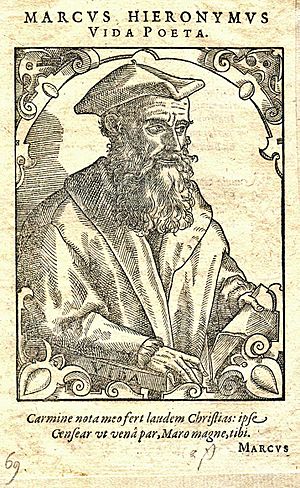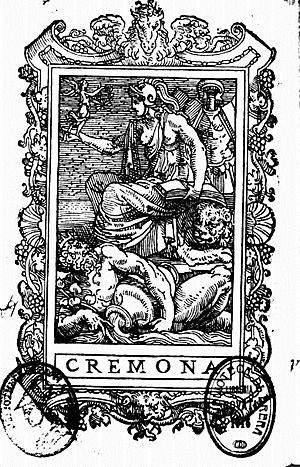Marco Girolamo Vida facts for kids
Marco Girolamo Vida (born around 1485, died September 27, 1566) was an important Italian writer and church leader. He was a humanist, which means he studied classical Greek and Roman culture. He was also a bishop and a poet.
Contents
Early Life and Education
Marco Girolamo Vida was born in a city called Cremona in Italy. His father, Guglielmo Vida, was a respected leader in the community. Marco had two brothers, Giorgio and Girolamo, and three sisters.
He started his studies in Cremona with a local teacher named Nicolò Lucari. Later, he went to study in other Italian cities like Mantua, Bologna, and Padua. It is thought that he joined a religious group called the Canons Regular around 1505.
Becoming a Church Leader
By 1510, Marco had received several church positions, known as benefices. These included roles in Ticengo, Monticelli, Solarolo Monestirolo, and Paderno.
He later joined the court of Pope Leo X, who was the leader of the Catholic Church. Pope Leo X gave him another important church position in Frascati. Later, Pope Clement VII made him a Protonotary Apostolic, which is a high rank in the Church.
Bishop of Alba
On February 7, 1533, Marco Girolamo Vida became the bishop of Alba. This was a very important role.
However, in 1544, the area around Alba was taken over by the French army. This happened during a long war between France and Spain. Bishop Vida had to leave Alba and go back to his church positions in Cremona.
He attended the Council of Trent in 1546 and 1547. This was a very important meeting of church leaders. In 1549 and 1550, he helped his hometown of Cremona in a disagreement with the city of Pavia. He wrote a strong defense for Cremona, showing his skill in writing.
Bishop Vida passed away on September 27, 1566.
His Famous Writings
Marco Girolamo Vida wrote many poems in Latin, the language of ancient Rome. He often wrote in the style of the famous Roman poet Virgil.
Two of his most well-known poems were published in 1527:
- De arte poetica: This poem, meaning "On the Art of Poetry," teaches about how to write good poetry. It was partly inspired by another Roman poet, Horace.
- Scacchia Ludus: This poem, meaning "The Game of Chess," is about the game of chess. It became very popular and was translated into many different languages.
His biggest work was a long Latin poem called Christiados libri sex. This means "The Christiad in Six Books." It was an epic poem, like the famous stories of ancient heroes. Vida wrote it in the style and language of Virgil. He started writing it when Pope Leo X was alive, but he finished it in the early 1530s. It was published in 1535.
See also
 In Spanish: Marco Girolamo Vida para niños
In Spanish: Marco Girolamo Vida para niños



